PROTECTED REPTILES AND AMPHIBIANS
The Endangered Species Act of 1973 (ESA) allows the US Fish and Wildlife Service and the National Marine Fisheries Service to list species of plants and animals as federally threatened or endangered. These United States designations are defined as follows:
- “Endangered” means a species is in danger of extinction throughout all or a significant portion of its range.
- “Threatened” means a species is likely to become endangered within the foreseeable future.
The State Endangered Species Act (N.C. General Statutes Chapter 113 Article 25) empowers with N.C. Wildlife Resources Commission to recognize species as needing additional conservation. State-listed designations and their definitions are as follows:
- “North Carolina Endangered” designation is given to any native or once-native species of wild animal whose continued existence as a viable component of the State’s fauna is determined by the Wildlife Resources Commission to be in jeopardy or any wild animal determined to be “‘Endangered” pursuant to the ESA.
- “North Carolina Threatened” designation is given to any native or once-native species of wild animal that is likely to become an endangered species within the forseeable future throughout all of a significant portion of its range or one that is designated as “Threatened” pursuant to the ESA.
- “North Carolina Special Concern” designation is given to any species of wild animal native or once native to North Carolina that is determined by the Wildlife Resources Commission to require monitoring but that may be taken under regulations adopted under the provisions of Article 25.
Species with either a United States or a North Carolina designation should be addressed in your forest management plan and taken into consideration during all activities in your woodlands.
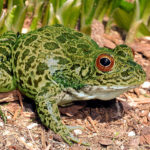 |
The Carolina Gopher Frog is state listed as North Carolina endangered. These rare frogs occur at scattered localities in the Sandhills and southeastern Coastal Plain. Little is known about their natural history outside the breeding season. Adults are secretive, spending most of their lives underground. |
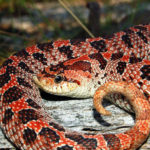 |
The Southern Hognose Snake is North Carolina threatened. These snakes are found in sandy fields and woods of the Coastal Plain and Sandhills region of the state. It is a secretive snake that spends much of its time under surface litter of underground. |
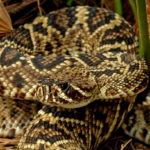 |
The Eastern Diamondback Rattlesnake is North Carolina endangered, but may have been extirpated because none have been seen in the state since the early 1990’s. The eastern diamondback Rattlesnake receives no federal protection despite the fact that it has declined over much of its range. In areas where it does still exist, this species usually inhabits dry sandy areas, palmetto or wiregrass flatwoods, pinewoods, coastal dune habitats, or hardwood hammocks.
|
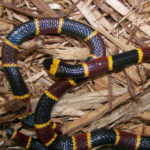 |
Eastern coral snakes are very rare in North Carolina and are considered North Carolina endangered. They live in sandy areas and stay underground most of the time. It is a venomous snake that can be distinguished from nonvenomous mimics because coral snakes have yellow bands adjacent to their red bands and a black snout instead of a red snout. An old poem is a helpful reminder: “Red and black, friend of Jack; red and yellow, kill a fellow.” |
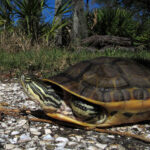 |
Chicken turtles are a North Carolina species of special concern. They are found in the Coastal Plain of the southeastern U.S. but are absent from the Piedmont and Mountains. In North Carolina they live in the Sandhills region in forested wetlands associated with longleaf pine forests. This species is among the most terrestrial of our turtles and nearly all males and some females leave the wetland each fall to spend the winter buried in the forest. Additionally, during drought this species aestivates in uplands rather than migrating to other wetlands. |
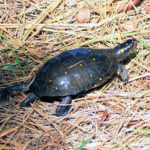 |
The spotted turtle is not an officially protected species, but the U.S. Fish and Wildlife Service considers the spotted turtle an at-risk species – one that will be evaluated for listing under the Endangered Species Act. It is also on the North Carolina animal watch list as a species whose population is known to be declining. They live in the eastern half of the state in a variety of wetland types, including swamps, bogs, marshes, small streams, wet meadows, and wet forests. |






